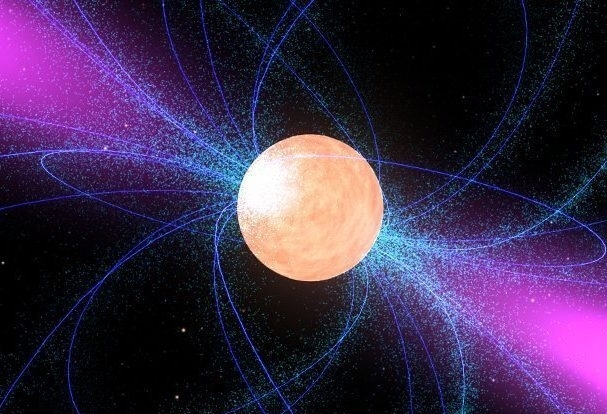



Astronomers discover record-breaking magnetic field in space, and it's epic

Baku, July 19, AZERTAC
Far out in the Milky Way, roughly 22,000 light years from Earth, a star unlike any other roars with a magnetic force that beats anything physicists have ever seen, according to Science alert.
At a whopping 1.6 billion Tesla, a pulsar called Swift J0243.6+6124 smashes the previous records of around 1 billion Tesla, discovered surrounding the pulsars GRO J1008-57 and 1A 0535+262.
For a bit of context, your average novelty fridge magnet comes in at around 0.001 Tesla. The more powerful MRI machines manage to hit around 3 Tesla.
A few years ago, engineers earned a pat on the back for achieving a semi-respectable 1,200 Tesla, sustaining it for a blink of just 100 microseconds.
So it stands to reason that 1.6 billion Tesla is going to demand some truly mind-blowing physics. The kind only achievable by massive objects crammed into impossible volumes and spun at incredible speeds, fast enough to accelerate electrons to ridiculous velocities.
Swift J0243.6+6124 was already regarded as a star worth paying attention to. A type of super-compact cosmic heavyweight known as a pulsar, it's the only X-ray source in our galaxy to fall into the ultra-luminous category.
It's also the only example in the Milky Way of an X-ray pulsar with a Be-type companion star feeding it matter fast enough to generate radio-emitting jets of matter from its poles.
Those features alone add up to a unique opportunity in our galactic backyard astronomers can't help but study in detail.
Measuring the magnetic field of a far-distant object is easier said than done, though. As strong as they are, those fields quickly weaken to become undetectable over distances of thousands of light years.
Fortunately clues can be found in the way that the ultra-bright glow of X-rays scatters from the electrons whizzing down the magnetic racetrack, something known as a cyclotron resonance scattering feature.
China's launch of the X-ray observatory Insight-HXMT in 2017 provides astrophysicists with a way to capture signatures like these in distant emissions, leading to the measure of electron energies in the GRO J1008-57 field in 2020.
Turkish study identifies microplastics in brain cells
ADA University-hosted Caspian Basin Studies Program wraps up
Turkish AI defense firm secures investment at valuation of $12.5M